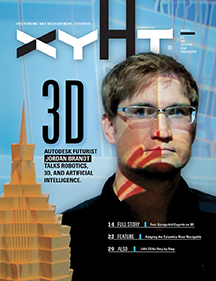Stand in the place where you live
Now face North
Think about direction
Wonder why you haven’t before
Why an obscure geodetic expression? It’s not all that obscure—it represents a foundational element requisite to nearly all human endeavor. It touches your life explicitly and in the abstract.
All of the ways that humans have measured and gauged their world, each of the conventions they have used to visualize and convey representations of this physical world (posit), could boiled down and be expressed via the simple variants of “xyHt”: fore-aft (x), left-right (y), up-down (H), and epoch/time (t).
This “DNA” of positioning is expressed as latitude/longitude, coordinates, orthometric elevation or even height above sea level—all expressions of location and geophysical shape originating in the root language of surveying and geodesy, fundamental to our physical existence, yet understood by few and spoken by even fewer. Every home, building, road, bridge, dam, tilled field, navigation system, location-based app, wireless network, Google Earth plug-in, GPS, GIS, or any map throughout history share some of this common “DNA” and owe their viability to the work and legacy of surveyors and geodesists.
It is no accident that humans have chosen to express their world in terms of “xyHt”—this is how the human body and our senses view and navigate our physical surroundings. We stand erect for a high vantage, and we plumb to the gravitational center of our home orb. We orient ourselves to the horizons via the observed passage of our life-giving sun; our lives move to the rhythms of the sun, moon, seasons, and changes to our geophysical surroundings brought by the years.
We are effectively walking surveying instruments, with level vials in our ears, gauging angles via the geometry of our limbs and the movement of the axis of our head and eyes. We judge distance and shape via stereovision, observing lines of perspective, echoes, resonance, touch, and heuristics borne of lifetimes of conscious and unconscious observation.
The devices, systems, and instrumentation we have developed often merely mimic this “organic surveying instrument,” and even the most sophisticated technologies used to store the data of geosciences take cues from the workings of the human brain. Indeed, modern science has identified the workings of “place” and “border” cells in the hippocampus region of the brain and how we make literal “mental maps” of our surroundings.
An example is the booming field of automated feature recognition, like how a camera can recognize and focus on a human face or a vehicle-mounted mobile laser scanner can pick out and identify a specific type of road sign from a digital library. The human brain does not reserve dedicated synapses for the face of every person we know; instead the basic geometry of a human face is stored, and we merely reserve data markers for what is unique about each of our acquaintances faces. These marvels of image and data compression that bring an entire virtual world to our smart phones are another example of this principle of stored root patterns.
So many of the geospatial sciences, positioning, navigation, and location-based disciplines, have sprung from these common roots or are reaching new heights fueled by the power of precise measurement and data management. Civil engineering, construction, transportation, precision navigation, machine guidance, robotics, resource and asset management, location-based services—these professional and industrial beneficiaries of enhancements in geoscience technologies depend on the language of xyHtinmuch the same manner as the digital world breathes binary code.
A revolution in precise positioning has reached into agriculture with GPS-guided tractors; it now guides autonomous robots on land, in the air, on and under the sea; it helps us find a nearby restaurant of our liking; feeds tsunami warning systems, warns us of vehicles in our blind spots, populates the displays of smart phones and the new wave of “wearables.” xyHt is the “paint” of the physical and virtual worlds of scientists, gamers, planners, consumers, and our classrooms.
Seemingly disparate disciplines, in the consumer, “prosumer,” and professional realms share this “DNA”—the legacy, and language of xyHt—and increasingly, a promising future.
Join team xyHt in exploring your world and discover new opportunities enabled by the power of precise location, positioning, and measurement. Be prepared to venture out of your comfort zone or industry silo, but be prepared to be pleasantly surprised. You might find technologies and methods being used in fields and industries unfamiliar to you that might just be the solutions you are looking for—or never thought to look for.

